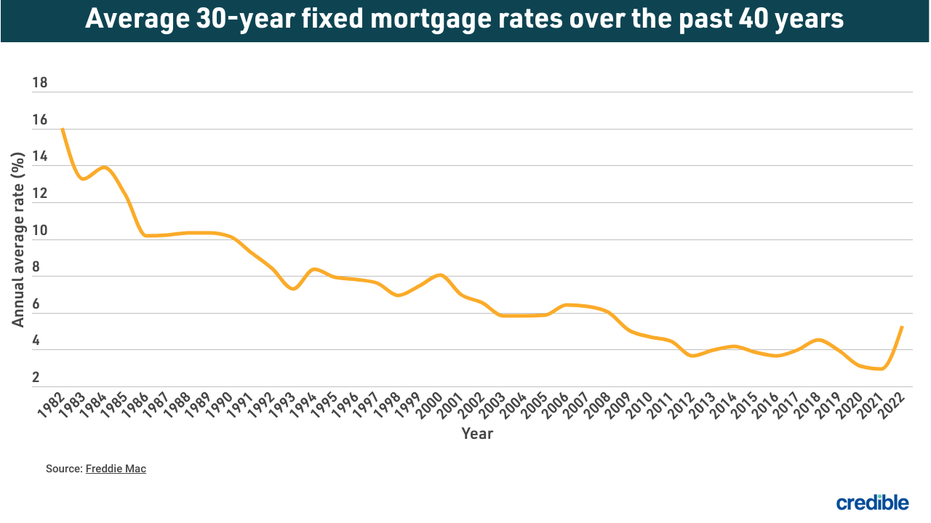Today’s mortgage rates: Look to 15-year rates for maximum savings | Jan. 23, 2023
Mortgage rates rise across all terms, but borrowers will find the greatest savings opportunity with a 15-year term

Check out the mortgage rates for Jan. 23, 2023, which are up from last Friday. (Credible)
Based on data compiled by Credible, mortgage rates for home purchases have risen across all terms since last Friday.
- 30-year fixed mortgage rates: 6.875%, up from 6.500%, +0.375
- 20-year fixed mortgage rates: 6.500%, up from 6.375%, +0.125
- 15-year fixed mortgage rates: 6.375%, up from 6.250%, +0.125
- 10-year fixed mortgage rates: 6.625%, up from 6.500%, +0.125
Rates last updated on Jan. 23, 2023. These rates are based on the assumptions shown here. Actual rates may vary. Credible, a personal finance marketplace, has 5,000+ Trustpilot reviews with an average star rating of 4.7 (out of a possible 5.0).
What this means: Mortgage rates for home purchases edged up across all terms today, with 30-year rates rising more than a quarter of a percentage point. Still, homebuyers who want to save the most on interest should consider a shorter term. Rates for a 15-year mortgage are half a point lower than rates for a 30-year mortgage. Comparing rates from multiple lenders can help buyers find the best possible deal for their unique financial situation.
To find great mortgage rates, start by using Credible’s secured website, which can show you current mortgage rates from multiple lenders without affecting your credit score. You can also use Credible’s mortgage calculator to estimate your monthly mortgage payments.
Based on data compiled by Credible, mortgage refinance rates are mixed today, with two key terms rising and two other terms holding steady since last Friday.
- 30-year fixed-rate refinance: 6.500%, unchanged
- 20-year fixed-rate refinance: 6.125%, up from 6.000%, +0.125
- 15-year fixed-rate refinance: 6.125%, up from 6.000%, +0.125
- 10-year fixed-rate refinance: 6.250%, unchanged
Rates last updated on Jan. 23, 2023. These rates are based on the assumptions shown here. Actual rates may vary. With 5,000 reviews, Credible maintains an "excellent" Trustpilot score.
What this means: Mortgage refinance rates rose for 20- and 15-year repayment terms today, while 30- and 10-year rates held steady. But homeowners looking to save the most on interest may want to consider a 15-year term. At 6.125%, a 15-year mortgage refinance offers a relatively low interest rate and the ability to be mortgage-free sooner. But with 20-year rates more than a quarter of a percentage point lower than 30-year rates, homeowners who want to refinance into a longer repayment term should stick with a 20-year refinance.
How mortgage rates have changed over time
Today’s mortgage interest rates are well below the highest annual average rate recorded by Freddie Mac — 16.63% in 1981. A year before the COVID-19 pandemic upended economies across the world, the average interest rate for a 30-year fixed-rate mortgage for 2019 was 3.94%. The average rate for 2021 was 2.96%, the lowest annual average in 30 years.
The historic drop in interest rates means homeowners who have mortgages from 2019 and older could potentially realize significant interest savings by refinancing with one of today’s lower interest rates. When considering a mortgage refinance or purchase, it’s important to take into account closing costs such as appraisal, application, origination and attorney’s fees. These factors, in addition to the interest rate and loan amount, all contribute to the cost of a mortgage.

How Credible mortgage rates are calculated
Changing economic conditions, central bank policy decisions, investor sentiment and other factors influence the movement of mortgage rates. Credible average mortgage rates and mortgage refinance rates reported in this article are calculated based on information provided by partner lenders who pay compensation to Credible.
The rates assume a borrower has a 740 credit score and is borrowing a conventional loan for a single-family home that will be their primary residence. The rates also assume no (or very low) discount points and a down payment of 20%.
Credible mortgage rates reported here will only give you an idea of current average rates. The rate you actually receive can vary based on a number of factors.
Factors that influence mortgage rates (and are in your control)
Many factors affect what mortgage interest rate you can qualify for, and some of them are within your control. Improving these factors could help you qualify for a lower interest rate.
- Credit score — Generally, the lowest interest rates go to borrowers with the highest credit scores.
- Debt-to-income ratio — DTI is a percentage that compares your total debts with your income. To calculate DTI, divide your monthly gross income by the total of all your monthly minimum debt payments. Generally, lenders prefer a DTI of 35% or less.
- Down payment amount — Generally, lenders (and many sellers) look favorably on a higher down payment amount. If you put down less than 20% of the home’s purchase price, many lenders will require you to pay for private mortgage insurance, which protects the lender (not you) if you fail to repay the mortgage.
- Home location/price — Interest rates can vary depending on what state you live in and where in the state you’re buying. Likewise, if you need to borrow a lot more than average (a jumbo loan) or very little, you may get a higher interest rate.
- Repayment term — The lowest rates typically come with 10- or 15-year terms, while 30-year terms usually have the highest interest rates.
If you’re trying to find the right mortgage rate, consider using Credible. You can use Credible's free online tool to easily compare multiple lenders and see prequalified rates in just a few minutes.
Have a finance-related question, but don't know who to ask? Email The Credible Money Expert at moneyexpert@credible.com and your question might be answered by Credible in our Money Expert column.
